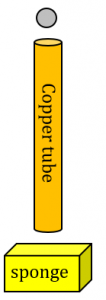Question 3:
Figures 2 and 3 show the induced currents produced when there is relative motion between a bar magnet and a solenoid.

(a) What is the meaning of induced current?
(b) Based on the direction of the current given in Figures 2 and 3, state the magnetic polarities at ends X and Y of the solenoid.
(c) State the direction of motion of the bar magnet in Figure 2 and Figure 3.
(d) Suggest two ways to increase the magnitude of the induced current in Figure 3.
Answer:
(a)
Induced current is the current produced in a conductor when there is relative motion between the conductor and a magnet that causes the conductor to cut magnetic field lines.
(b)

Figure (2): Direction of motion of magnet to the left
(d)
Increase the number turns of the solenoid
Figures 2 and 3 show the induced currents produced when there is relative motion between a bar magnet and a solenoid.

(a) What is the meaning of induced current?
(b) Based on the direction of the current given in Figures 2 and 3, state the magnetic polarities at ends X and Y of the solenoid.
(c) State the direction of motion of the bar magnet in Figure 2 and Figure 3.
(d) Suggest two ways to increase the magnitude of the induced current in Figure 3.
Answer:
(a)
Induced current is the current produced in a conductor when there is relative motion between the conductor and a magnet that causes the conductor to cut magnetic field lines.
(b)

X : north pole
Y : south pole
Figure (2): Direction of motion of magnet to the left
Figure (3): Direction of motion of magnet to the right
(d)
Increase the number turns of the solenoid
Increase the speed of motion of the magnet
Question 4:
A transformer is used to step down voltage from 240 V to 6 V for an electronic equipment. The current in the primary coil is 0.18 A. What is the current in the secondary coil? State the assumption that needs to be made in your calculation.
Answer:
$$ \begin{aligned} & V_{\mathrm{P}}=240 \mathrm{~V} \\ & V_{\mathrm{S}}=6 \mathrm{~V} \\ & I_{\mathrm{P}}=0.18 \mathrm{~A} \\ & I_{\mathrm{S}}=? \end{aligned} $$
$$ \begin{aligned} V_{\mathrm{S}} I_{\mathrm{S}} & =V_{\mathrm{P}} I_{\mathrm{P}} \\ 6 \times I_{\mathrm{S}} & =240 \times 0.18 \\ I_{\mathrm{S}} & =\frac{240 \times 0.18}{6} \\ I_{\mathrm{S}} & =7.2 \mathrm{~A} \end{aligned} $$
A transformer is used to step down voltage from 240 V to 6 V for an electronic equipment. The current in the primary coil is 0.18 A. What is the current in the secondary coil? State the assumption that needs to be made in your calculation.
Answer:
$$ \begin{aligned} & V_{\mathrm{P}}=240 \mathrm{~V} \\ & V_{\mathrm{S}}=6 \mathrm{~V} \\ & I_{\mathrm{P}}=0.18 \mathrm{~A} \\ & I_{\mathrm{S}}=? \end{aligned} $$
$$ \begin{aligned} V_{\mathrm{S}} I_{\mathrm{S}} & =V_{\mathrm{P}} I_{\mathrm{P}} \\ 6 \times I_{\mathrm{S}} & =240 \times 0.18 \\ I_{\mathrm{S}} & =\frac{240 \times 0.18}{6} \\ I_{\mathrm{S}} & =7.2 \mathrm{~A} \end{aligned} $$
The loss of energy from the transformer can be neglected, that is the transformer is ideal.
Question 5:
Figure 4 shows two identical metal balls and a copper tube. One of the balls is a neodymium magnet while the other is a steel ball.

Design an activity that can identify which ball is the neodymium magnet. Explain the physics principle used in your activity.
Answer:

The copper tube is held vertically with a piece of sponge below it.
Release the metal balls one by one to fall through the copper tube onto the sponge.
The ball that takes a shorter time to fall onto the sponge is the steel ball.
The ball that takes a longer time to fall onto the sponge is the neodymium magnet ball.
When the neodymium magnet ball falls, magnetic field lines cut the copper tube.
Eddy currents are induced in the copper tube.
According to Lenz’s law, the eddy currents will produce a magnetic field that opposes the motion of the neodymium ball.
Since the neodymium magnet is a strong magnet and copper is a good conductor.
The eddy currents produce a strong magnetic field. Therefore, the fall of the neodymium magnet ball is slowed down.
Figure 4 shows two identical metal balls and a copper tube. One of the balls is a neodymium magnet while the other is a steel ball.

Design an activity that can identify which ball is the neodymium magnet. Explain the physics principle used in your activity.
Answer:

The copper tube is held vertically with a piece of sponge below it.
Release the metal balls one by one to fall through the copper tube onto the sponge.
The ball that takes a shorter time to fall onto the sponge is the steel ball.
The ball that takes a longer time to fall onto the sponge is the neodymium magnet ball.
When the neodymium magnet ball falls, magnetic field lines cut the copper tube.
Eddy currents are induced in the copper tube.
According to Lenz’s law, the eddy currents will produce a magnetic field that opposes the motion of the neodymium ball.
Since the neodymium magnet is a strong magnet and copper is a good conductor.
The eddy currents produce a strong magnetic field. Therefore, the fall of the neodymium magnet ball is slowed down.
